
Does growing your own food matter?
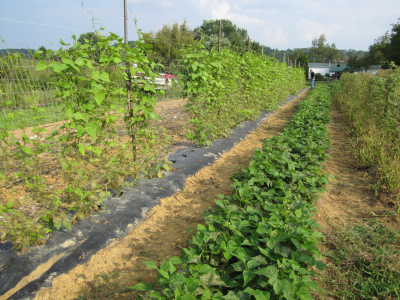 Roland sent me a link to an
intriguing article in the New York Times called "Math
Lessons for Locavores."
The author argues that locavores need to take a harder look at the
facts and realize that the distance food travels before it reaches
their plates accounts for only 14% of the total energy costs of their
eating habits. While I like Stephen Budiansky's focus on numbers,
the author's conclusion doesn't make as much sense to me. He ends
his article by saying, in essence, that our current agricultural system
is just peachy. I couldn't agree less.
Roland sent me a link to an
intriguing article in the New York Times called "Math
Lessons for Locavores."
The author argues that locavores need to take a harder look at the
facts and realize that the distance food travels before it reaches
their plates accounts for only 14% of the total energy costs of their
eating habits. While I like Stephen Budiansky's focus on numbers,
the author's conclusion doesn't make as much sense to me. He ends
his article by saying, in essence, that our current agricultural system
is just peachy. I couldn't agree less.
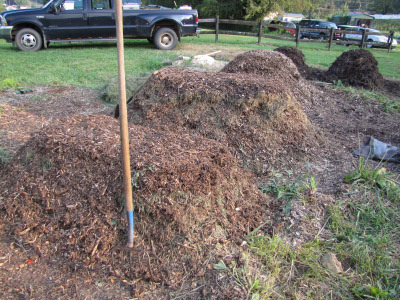 Here's
a quick example to help you see one small reason why I think that even
mainstream organic farming is fatally flawed. While touring Abingdon
Organics, I was
shocked to hear that Anthony tosses 200 pounds of culled tomatoes and
peppers in his compost pile every week. Mark and I once attended
a few meetings as potential growers for Anthony's organic gardening
marketing association, and I can personally attest that those culls
aren't nearly as bad as the tomato I
chewed Mark out for throwing to the chickens a few weeks ago.
Chances are, the culled vegetables had a slightly odd shape, were too
big or too small, or had a minute blemish. A hundred years ago,
those culls would have been known as "food", or, at the worst, would
have fed pigs or chickens that would quickly become human food.
Here's
a quick example to help you see one small reason why I think that even
mainstream organic farming is fatally flawed. While touring Abingdon
Organics, I was
shocked to hear that Anthony tosses 200 pounds of culled tomatoes and
peppers in his compost pile every week. Mark and I once attended
a few meetings as potential growers for Anthony's organic gardening
marketing association, and I can personally attest that those culls
aren't nearly as bad as the tomato I
chewed Mark out for throwing to the chickens a few weeks ago.
Chances are, the culled vegetables had a slightly odd shape, were too
big or too small, or had a minute blemish. A hundred years ago,
those culls would have been known as "food", or, at the worst, would
have fed pigs or chickens that would quickly become human food.
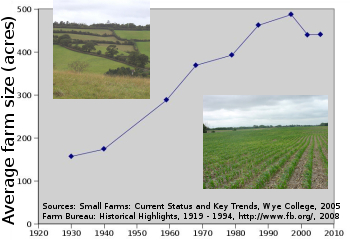 In
my opinion, the problem with mainstream agriculture is not the miles
food travels to get to our plates; the problem is sheer size.
Over the last hundred years, farmers
have been forced to grow food on larger and larger acreages or go out
of business, with
the result that they simply cannot keep the farm ecosystem
balanced. Pollution from concentrated animal feeding operations
is yet another example. Just as today's culls used to turn into
yesteryear's soups, today's problem manure used to be yesteryear's
black gold.
In
my opinion, the problem with mainstream agriculture is not the miles
food travels to get to our plates; the problem is sheer size.
Over the last hundred years, farmers
have been forced to grow food on larger and larger acreages or go out
of business, with
the result that they simply cannot keep the farm ecosystem
balanced. Pollution from concentrated animal feeding operations
is yet another example. Just as today's culls used to turn into
yesteryear's soups, today's problem manure used to be yesteryear's
black gold.
 Although
the average eater can't shut down factory farms or change the policies
that make the typical American farm a 400 acre monoculture, we can take
simple actions that will start to change the system. Forget the
greenwashing labels on the food from the grocery store and start
thinking about your own growing, cooking, and refrigerating
habits. In "Math Lessons for Locavores", Stephen Budiansky wrote
that 32% of food energy costs come from refrigerating and cooking that
food at home. If you grow your own vegetables, you won't need to
run one of those huge refrigerators that grace the modern home --- you
just take the food out of the garden, cook gently, and throw it on your
plate, putting the leftovers in a smaller, energy-efficient
model. A rocket stove is on our winter project list to further
lower our energy footprint.
Although
the average eater can't shut down factory farms or change the policies
that make the typical American farm a 400 acre monoculture, we can take
simple actions that will start to change the system. Forget the
greenwashing labels on the food from the grocery store and start
thinking about your own growing, cooking, and refrigerating
habits. In "Math Lessons for Locavores", Stephen Budiansky wrote
that 32% of food energy costs come from refrigerating and cooking that
food at home. If you grow your own vegetables, you won't need to
run one of those huge refrigerators that grace the modern home --- you
just take the food out of the garden, cook gently, and throw it on your
plate, putting the leftovers in a smaller, energy-efficient
model. A rocket stove is on our winter project list to further
lower our energy footprint.
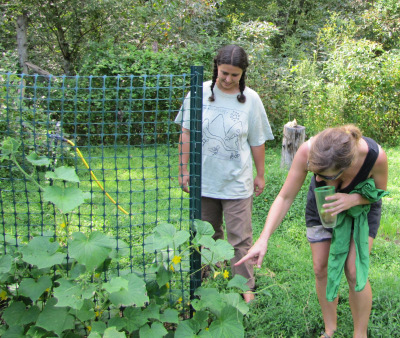 Truthfully,
though, I think that even those steps are a bit cosmetic. The
real way to make your eating habits an asset to the planet rather than
an oozing sore is to grow your own food on a small enough scale that
you can put all of the "waste" back into the farm to feed the
soil. Although you don't hear it bandied about much, I see no
reason why adding compost to your soil and growing cover crops wouldn't
count as carbon sequestration --- after all, humus can take up to a
thousand years to decompose. Add in some livestock to make the
ecosystem more complete, and you've got a simple permaculture farm that
feeds butterflies and birds as well as humans.
Truthfully,
though, I think that even those steps are a bit cosmetic. The
real way to make your eating habits an asset to the planet rather than
an oozing sore is to grow your own food on a small enough scale that
you can put all of the "waste" back into the farm to feed the
soil. Although you don't hear it bandied about much, I see no
reason why adding compost to your soil and growing cover crops wouldn't
count as carbon sequestration --- after all, humus can take up to a
thousand years to decompose. Add in some livestock to make the
ecosystem more complete, and you've got a simple permaculture farm that
feeds butterflies and birds as well as humans.
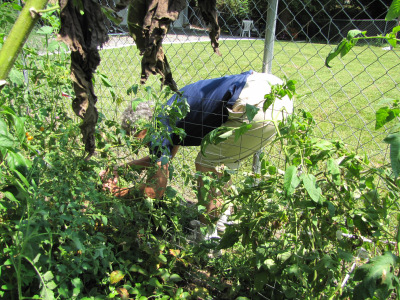 If
growing your own food is so great, why don't we see more people jumping
on the bandwagon? Well, there's very little profit in it, for one
thing, so marketers feel no need to spread the word. Growing your
own food also takes time and effort, and we're all inherently lazy
people who would far rather think we were changing the world by paying
double for a zucchini marked "organic" than putting down a kill mulch
in the backyard and getting to work. To top our reasons off,
everyone knows that the average American is far too busy to commit 15
hours a week to growing crops, even though we easily spend that much
time in front of a TV. And, heck, what can one person's actions
do? How quickly we forget that during World War II, little
backyard victory gardens
produced 40% of Americans' food.
If
growing your own food is so great, why don't we see more people jumping
on the bandwagon? Well, there's very little profit in it, for one
thing, so marketers feel no need to spread the word. Growing your
own food also takes time and effort, and we're all inherently lazy
people who would far rather think we were changing the world by paying
double for a zucchini marked "organic" than putting down a kill mulch
in the backyard and getting to work. To top our reasons off,
everyone knows that the average American is far too busy to commit 15
hours a week to growing crops, even though we easily spend that much
time in front of a TV. And, heck, what can one person's actions
do? How quickly we forget that during World War II, little
backyard victory gardens
produced 40% of Americans' food.
I'll step down off my
soapbox now. Thanks for reading a post that got way too
long! Feel free to tear my reasoning apart in the comments.
Want more in-depth information? Browse through our books.
Or explore more posts by date or by subject.
About us: Anna Hess and Mark Hamilton spent over a decade living self-sufficiently in the mountains of Virginia before moving north to start over from scratch in the foothills of Ohio. They've experimented with permaculture, no-till gardening, trailersteading, home-based microbusinesses and much more, writing about their adventures in both blogs and books.
Want to be notified when new comments are posted on this page? Click on the RSS button after you add a comment to subscribe to the comment feed, or simply check the box beside "email replies to me" while writing your comment.

Lisa --- we probably make gardening look harder than it really is. We're always trying out so many different things that we do fill up about half of our days with farm work, but the actual time spent growing all of the vegetables and some of the fruits that two people eat takes up only about 10 hours per week. That figure includes growing and freezing enough food to take us all the way through the winter, so if you wanted to start out by just growing enough fresh food for your family during the main growing season, I'll bet you could put in as little as 1 hour per day! A commitment that small could probably fit much more easily into your schedule, I suspect.
AB --- Taste is a very excellent point, as is the nutrition that the taste represents. I wasn't really going there in this post because it already got way, way too long, but there are clearly benefits to local eating that don't get touched on when you merely look at the energy consumed to get the food from farm to plate. As both you and Lisa pointed out, supporting small farmers is also another bonus of eating locally --- not only are you putting money into the local economy, but you're also voting with your wallet to keep farm sizes small and the environment more pristine.
Actually, wrt regfigerator efficiency bigger is better. Suppose you have a refrigerator that is a cube (all edges the same length) for the sake of easy calculation. Consider that for a given temperature difference between inside and outside and a given insulation material and thickness heat infiltration is lineairly dependant on surface area (which scales with the square of the characteristic length), while storage volume scales with the characteristic length cubed.
So if you make the edge twice as big, the surface area (and therefore energy usage) grows by a factor of four, but the volume grows by a factor of eight! So the cooling energy needed per unit of volume is cut in half.